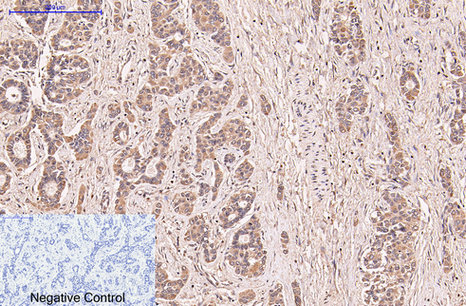Dipeptidyl-peptidase 1 (light chain, Cleaved-Asp395) rabbit pAb
- 货号:YC0151
- 应用:WB;ELISA
- 种属:Human;Rat;Mouse;
- 靶点:
- Dipeptidyl-peptidase 1
- 简介:
- >>Lysosome;>>Apoptosis
- 基因名称:
- CTSC CPPI
- 蛋白名称:
- Dipeptidyl-peptidase 1 (light chain, Cleaved-Asp395)
- Human Gene Id:
- 1075
- Human Swiss Prot No:
- P53634
- Mouse Gene Id:
- 13032
- Mouse Swiss Prot No:
- P97821
- Rat Gene Id:
- 25423
- Rat Swiss Prot No:
- P80067
- 免疫原:
- Synthesized peptide derived from human Dipeptidyl-peptidase 1 (light chain, Cleaved-Asp395)
- 特异性:
- This antibody detects endogenous levels of Human Dipeptidyl-peptidase 3 (light chain, Cleaved-Asp395, protein was cleaved amino acid sequence between 394-395 )
- 组成:
- Liquid in PBS containing 50% glycerol, 0.5% BSA and 0.02% sodium azide.
- 来源:
- Polyclonal, Rabbit,IgG
- 稀释:
- WB 1:1000-2000 ELISA 1:5000-20000
- 纯化工艺:
- The antibody was affinity-purified from rabbit serum by affinity-chromatography using specific immunogen.
- 浓度:
- 1 mg/ml
- 储存:
- -15°C to -25°C/1 year(Do not lower than -25°C)
- 其他名称:
- Dipeptidyl peptidase 1 (EC 3.4.14.1;Cathepsin C;Cathepsin J;Dipeptidyl peptidase I;DPP-I;DPPI;Dipeptidyl transferase) [Cleaved into: Dipeptidyl peptidase 1 exclusion domain chain (Dipeptidyl peptidase I exclusion domain chain);Dipeptidyl peptidase 1 heavy chain (Dipeptidyl peptidase I heavy chain);Dipeptidyl peptidase 1 light chain (Dipeptidyl peptidase I light chain)]
- 实测条带:
- 8kD
- 背景:
- catalytic activity:Release of an N-terminal dipeptide, Xaa-Yaa-|-Zaa-, except when Xaa is Arg or Lys, or Yaa or Zaa is Pro.,cofactor:Binds 1 chloride ion per heavy chain.,disease:Defects in CTSC are a cause of Haim-Munk syndrome (HMS) [MIM:245010]; also known as keratosis palmoplantaris with periodontopathia and onychogryposis or Cochin Jewish disorder. HMS is an autosomal recessive disorder characterized by palmoplantar keratosis, onychogryphosis and periodontitis. Additional features are pes planus, arachnodactyly, and acroosteolysis.,disease:Defects in CTSC are a cause of juvenile periodontitis (JPD) [MIM:170650]; also known as prepubertal periodontitis (PPP). JPD is characterized by severe and protracted gingival infections, leading to tooth loss. JPD inheritance is autosomal dominant.,disease:Defects in CTSC are a cause of Papillon-Lefevre syndrome (PLS) [MIM:245000]; also known as keratosis palmoplantaris with periodontopathia. PLS is an autosomal recessive disorder characterized by palmoplantar keratosis and severe periodontitis affecting deciduous and permanent dentitions and resulting in premature tooth loss. The palmoplantar keratotic phenotype vary from mild psoriasiform scaly skin to overt hyperkeratosis. Keratosis also affects other sites such as elbows and knees.,enzyme regulation:Strongly inhibited by the cysteine peptidase inhibitors mersalyl acid, iodoacetic acid and cystatin. Inhibited by N-ethylmaleimide, Gly-Phe-diazomethane, TLCK, TPCK and, at low pH, by dithiodipyridine. Not inhibited by the serine peptidase inhibitor PMSF, the aminopeptidase inhibitor bestatin, or metal ion chelators.,function:Thiol protease. Has dipeptidylpeptidase activity. Active against a broad range of dipeptide substrates composed of both polar and hydrophobic amino acids. Proline cannot occupy the P1 position and arginine cannot occupy the P2 position of the substrate. Can act as both an exopeptidase and endopeptidase. Activates serine proteases such as elastase, cathepsin G and granzymes A and B. Can also activate neuraminidase and factor XIII.,induction:Up-regulated in lymphocytes by IL2.,online information:CTSC mutation db,PTM:In approximately 50% of the complexes the exclusion domain is cleaved at position 58 or 61. The two parts of the exclusion domain are held together by a disulfide bond.,PTM:N-glycosylated.,similarity:Belongs to the peptidase C1 family.,subunit:Tetramer of heterotrimers consisting of exclusion domain, heavy- and light chains.,tissue specificity:Ubiquitous. Highly expressed in lung, kidney and placenta. Detected at intermediate levels in colon, small intestine, spleen and pancreas.,
- 功能:
- proteolysis, immune response, aging, response to organic substance,
- 细胞定位:
- Lysosome.
- 组织表达:
- Ubiquitous. Highly expressed in lung, kidney and placenta. Detected at intermediate levels in colon, small intestine, spleen and pancreas.
- June 19-2018
- WESTERN IMMUNOBLOTTING PROTOCOL
- June 19-2018
- IMMUNOHISTOCHEMISTRY-PARAFFIN PROTOCOL
- June 19-2018
- IMMUNOFLUORESCENCE PROTOCOL
- September 08-2020
- FLOW-CYTOMEYRT-PROTOCOL
- May 20-2022
- Cell-Based ELISA│解您多样本WB检测之困扰
- July 13-2018
- CELL-BASED-ELISA-PROTOCOL-FOR-ACETYL-PROTEIN
- July 13-2018
- CELL-BASED-ELISA-PROTOCOL-FOR-PHOSPHO-PROTEIN
- July 13-2018
- Antibody-FAQs



